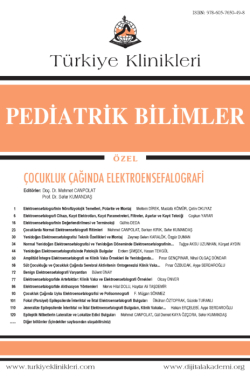The Periodic Electroencephalography Examples in Children
Mustafa ÇALIKa, Özlem ETHEMOĞLUb, Halil AYb
aÇocuk Nörolojisi BD,
bNöroloji AD, Harran Üniversitesi Tıp Fakültesi, Şanlıurfa, TÜRKİYE
Çalık M, Ethemoğlu Ö, Ay H. Çocuklarda periyodik elektroensefalografi örnekleri. Canpolat M, Kumandaş S, editörler. Çocukluk Çağında Elektroensefalografi. 1. Baskı. Ankara: Türkiye Klinikleri; 2019. p.141-6.
ABSTRACT
Periodic epileptiform activities are always considered abnormal when they occur in electroencephalographic (EEG) examination in children. They are uncommon EEG examples. Periodic epileptiform activities can also be lateralized or generalized. In this paper, various EEG samples related to periodic epileptiform activities are reported together with a main text.
Keywords: Epilepsy; electroencephalography; periodic epileptiform activity; children
Kaynak Göster
Referanslar
- Yeni SN, Bora İ. [Periyodik EEG örnekleri]. EEG Atlası. 1. Baskı. İstanbul: Nobel Tıp Kitabevleri; 2012. p.401-20.
- Orta DS, Chiappa KH, Quiroz AZ, Costello DJ, Cole AJ. Prognostic implications of periodic epileptiform discharges. Arch Neurol. 2009;66(8):985-91. [Crossref] [PubMed]
- García-Morales I, García MT, Galán-Dávila L, Gómez-Escalonilla C, Saiz-Díaz R, MartínezSalio A, et al. Periodic lateralized epileptiform discharges: etiology, clinical aspects, seizures, and evolution in 130 patients. J Clin Neurophysiol. 2002;19(2):172-7. [Crossref] [PubMed]
- Raroque HG Jr, Wagner W, Gonzales PC, Leroy RF, Karnaze D, Riela AR, et al. Reassessment of the clinical significance of periodic lateralized epileptiform discharges in pediatric patients. Epilepsia. 1993;34(2):275- 8. [Crossref] [PubMed]
- Walsh JM, Brenner RP. Periodic lateralized epileptiform discharges--long-term outcome in adults. Epilepsia. 1987;28(5):533-6. [Crossref] [PubMed]
- de la Paz D, Brenner RP. Bilateral independent periodic lateralized epileptiform discharges. Clinical significance. Arch Neurol. 1981;38(11):713-5. [Crossref] [PubMed]
- San-Juan OD, Chiappa KH, Costello DJ, Cole AJ. Periodic epileptiform discharges in hypoxic encephalopathy: BiPLEDs and GPEDs as a poor prognosis for survival. Seizure. 2009;18(5):365-8. [Crossref] [PubMed]
- Garg RK. Subacute sclerosing panencephalitis. J Neurol. 2008;14:1439-52. [Crossref] [PubMed]
- Anlar B. Subacute sclerosing panencephalitis: diagnosis and drug treatment options. CNS Drugs. 1997;7(2):111-20. [Crossref] [PubMed]
- Anlar B, Yalaz K, Ustaçelebi S. Clinical and laboratory findins in a series of subacute sclerosing panencephalitis. Turk J Pediatr. 1988;30(2):85-92.
- Giménez-Roldán S, Martín M, Mateo D, López-Fraile IP. Preclinical EEG abnormalities in subacute sclerosing panencephalitis. Neurology. 1981;31(6):763-7. [Crossref] [PubMed]
- Dunand AC, Jallon P. EEG-mediated diagnosis of an unusual presentation of SSPE. Clin Neurophysiol. 2003;114(4):737-9. [Crossref] [PubMed]
- Ekmekci O, Karasoy H, Gökçay A, Ulkü A. Atypical EEG findings in subacute sclerosing panencephalitis. Clin Neurophysiol. 2005;116(8):1762-77. [Crossref] [PubMed]
- Kandiah N, Tan K, Pan AB, Au WL, Venketasubramanian N, Tchoyoson Lim CC, et al. Creutzfeldt-Jakob disease: which diffusionweighted imaging abnormality is associated with periodic EEG complexes? J Neurol. 2008;255(9):1411-4. [Crossref] [PubMed]
- Wieser HG, Schindler K, Zumsteg D. EEG in Creutzfeldt-Jakob disease. Clin Neurophysiol. 2006;117(5):935-51. [Crossref] [PubMed]

